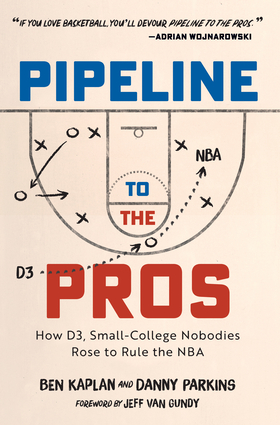Is there a new unbeaten path to the top of the NBA?
That’s the question Ben Kaplan and Danny Parkins aimed to answer with their book “Pipeline to the Pros,” which dives into the growing connection between Division III college programs and top positions in the NBA.
The book began with a simple observation. In 2020, Kaplan noticed that 12 of the 30 NBA teams were helmed in one way or another — whether coach, general manager or top executive — by a Division III alumnus.
When Kaplan called Parkins to share this information, it was odd. Up until that point, they didn’t talk on the phone. They had been friends since elementary school and lived 10 minutes apart at the time, but such proximity meant they never needed to call.
So a phone call from Kaplan meant business. It was a step outside of their comfort zones: Kaplan works in analytics and strategy management, while Parkins is the host of the “Parkins & Spiegel Show” on WSCR-AM 670. But once Parkins heard the pitch, he was ready to dive in.
“I love big projects,” Parkins said. “The radio show is the main thing and it’s my favorite thing and it’s the thing that I’m best at, but I’m always trying to do other things.”
It was the best and worst time to try writing a book. Parkins’ father was in the midst of a steep decline with Alzheimer’s disease. His brother had just been diagnosed with brain cancer. Parkins had a young son and another on the way. Shortly after they began research, Kaplan’s father was diagnosed with a rare form of cancer.
But amid the turmoil racking their lives, Parkins and Kaplan felt the book offered a much-needed sanctuary.
“We like to thank the book for allowing a couple of friends to work together on a project and escape from some of the serious things that we were dealing with,” Parkins said. “I think the acknowledgments might be my personal favorite part of the book, which is so self-indulgent and referential that I don’t like hearing myself say it. But that’s what the book was.
“It didn’t lessen the pain of our fathers being sick and dying, but it was nice to be able to talk to your best friend about that stuff and something else.”
Kaplan and Parkins embraced an extensive research timeline. Over three years, they spent hours on the phone with top experts around the NBA: Hubie Brown, Brad Stevens, Jeff Van Gundy, Stan Van Gundy, Phil Jackson, Dick Vitale, Daryl Morey, Frank Vogel. If they couldn’t secure an interview with a more elusive source such as Gregg Popovich, they phoned people like Popovich’s academic adviser when the legendary coach was playing for Pomona.
Through this process, a clear pattern emerged. The boom of Division III success in the NBA directly correlated with the rise of data and analytics, which in turn caused the game to shift farther behind the 3-point arc over the past decade.
“These guys are not responsible for analytics in the NBA,” Parkins said. “That’s the story of the NBA in the last 10 years. These guys are the types of people that understand why that is mathematically the correct thing to do, so they are more likely to get hired.
“They are smart, they are analytical, they have different backgrounds. And you have new owners who made their money in tech who have a better shot in believing in these types of people.”
The rise of analytics also mirrored a diminishment of former players taking key coaching and front-office roles across the league. Kaplan and Parkins believe this reflects the broadening scope of roles within NBA organizations, stretching from data analytics to film scouting to draft preparation.
In this context, it makes sense that front offices would look to hire from a variety of backgrounds that break the mold of traditional blue-blood basketball programs.
“The jobs have gotten so big and so complex in terms of all that you have to manage and all the information that you’re taking in and have to synthesize down,” Kaplan said. “That takes some training in the job beyond just the very valuable experience of having lived an NBA life for however long.”
While this pipeline has brought more diverse educational and intellectual backgrounds to the forefront in the NBA, Kaplan and Parkins were also wary of how it might deter the league’s goal of improving racial diversity at the highest executive levels.
In speaking with Black alumni of Division III programs such as Cleveland Cavaliers President Koby Altman and Houston Rockets general manager Rafael Stone, Parkins hopes they highlighted how front offices often fail to balance this aspect of hiring.
“We spent a lot of time thinking about how we were going to address the fact that this is an overwhelmingly majority Black league and this pipeline contributes to front offices and coaching staffs not matching up with the demographics of the players,” Parkins said. “Coaching staffs have actually made a pretty significant improvement in that area, but very recently, looking at the data, front offices are still lagging behind.”
Kaplan and Parkins can point out favorite memories from those years of research — their first interview with Jeff Van Gundy, long conversations with Stevens and Brown. But the best moment of the process for both writers was unboxing the first set of books and giving copies to their mothers.
While this book is about trends in basketball and talent pipelines across the NBA, at its heart it is a yearslong conversation between two friends about a shared love.
“Asking Danny to do this was not easy because the last thing I wanted to do was make him feel forced to do something, especially when he was going through so much,” Kaplan said. “It was a really amazing act of friendship for him to sign on and do this and make something that was my dream and passion project not only happen but happen way bigger than I would have ever dreamt of.”





